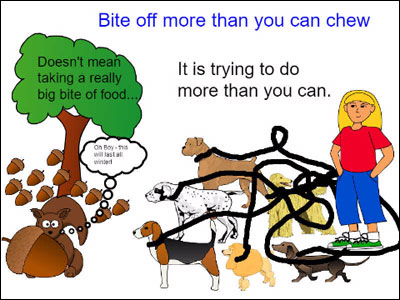
Students will illustrate and translate the meaning of an idiom to help others learn these examples of figurative language.

There is a new teacher at school who just loves to talk in idioms. The only problem is that most kids, and especially the English Language Learners, can’t understand a word this new teacher says! The Principal has asked your class to illustrate and translate the meaning of phrases like, “Rick Riordan’s latest series took second period by storm,” and “Today’s homework is going to be a piece of cake” so students can understand just what this teacher means. So “roll up your sleeves (get ready for a job) and put your noses to the grindstone (start working hard). It's time to get cracking (get started)!”
Begin reading a book like Ted Arnold's More Parts, Loren Leedy's There's a Frog in My Throat, or Marvin Terban's In a Pickle. Ask the students to describe what they are seeing as you are reading. Then, share the illustrations from the book. Discuss with your students.
Introduce the word idiom to your students as well as its definition. Idioms are colorful and help convey a lot of information in a small number of words. Idioms are more often used in speech than in writing, probably because you may need to know a bit about the background of a speaker to help you decode the meaning of the words. In fact, you can often recognize a word or phrase as an idiom because the literal meaning doesn’t make sense.
You might want to also explore the etymology from the Greek idíōma, which means ‘peculiarity.’ The idea is that the phrase is “one of a kind” or has a meaning different from the literal translation.
The English language includes over 15,000 idioms, but idioms are not unique to English, they are found in almost every language. For example, the English idiom a bull in a china shop is similar to the German ein Elefant in einem Porzellangeschäft (an elephant in a china shop). The English idiom make a mountain out of a molehill is similar to the French la montagne accouche d'une souris (the mountain gives birth to a mouse).
But similar combinations of words in different languages can also have very different meanings. For example, to be long in the tooth means to be old or out of date in English. But in French, avoir les dent longues (to have long teeth) means to be ambitious.
If your class or school includes students and teachers who speak languages other than English, ask them to share idioms they know in these languages!
Decide whether you want to address the problem as an entire class or work in small teams. Then, reintroduce the problem or task to your students.
The first step is to determine what the group wants to make to solve the problem. For example, will you create:
This may work as a great opportunity to brainstorm products students could create as a class and then let individual teams decide which one they think will work best.

If you want individual students to follow the same process and complete the same steps, an illustrated dictionary should meet your needs. You can even create an animated book in Wixie. Then, you can assign idioms to each student who then contributes a single page you can combine into a class dictionary.
Have students explore the Scholastic Idiom Dictionary, or idiom web sites, like Dave’s ESL Cafe to find the idiom, or idioms, they wish to address and illustrate.
Talk with students as they work to illustrate idiomatic language. Encourage them to add more details and create more complete and specific illustrations. This is a great time to catch misconceptions early and help students learn to love language as they explore etymology, history, and visual play.
If you are working together on one story, book, or dictionary, collect each student's page into one file and export to PDF or HTML to share with a wider audience. Print student work to share with classmates, families, and even language specialists at your school. Post the work to your classroom or school website or even iTunes channel!
Have each team present their product to the rest of the class or another class at your school. Depending on the products, you can hang posters around the school, share animations during morning announcements, or publish a book for the school media center.
Assess prior knowledge as you discuss the stories you have read and ask students to share idioms they already know. You can also get a sense of their fluency with idiomatic language by the choice of idiom they wish to tackle. As they develop their diagrams and illustrations, ask questions and engage in one-on-one dialog to catch misconceptions early and help them make connections between the concepts and ideas expresses through the idioms. The final products will help you evaluate how well students are able to translate what they have learned about idiomatic language into teaching materials to help others better understand them.
Arnold, Ted. More Parts. ISBN: 0142501492
Leedy, Loren. There's a Frog in My Throat! ISBN: 0823418197
Terban, Marvin. In a Pickle: And Other Funny Idioms. ISBN: 0618830014
Terban, Marvin. Scholastic's Dictionary of Idioms. ISBN: 0439770831
ESL Idiom Page at Dave's ESL Cafe eslcafe.com/idioms/id-list.html
Language Theme
4.5. Demonstrate understanding of figurative language, word relationships, and nuances in word meanings.
b. Recognize and explain the meaning of common idioms, adages, and proverbs.
5.5. Demonstrate understanding of figurative language, word relationships, and nuances in word meanings.
b. Recognize and explain the meaning of common idioms, adages, and proverbs.
6. Creative Communicator
Students communicate clearly and express themselves creatively for a variety of purposes using the platforms, tools, styles, formats and digital media appropriate to their goals. Students:
a. choose the appropriate platforms and tools for meeting the desired objectives of their creation or communication.
b. create original works or responsibly repurpose or remix digital resources into new creations.
d. publish or present content that customizes the message and medium for their intended audiences.

Follow us on Instagram for daily inspiration

Create a thought web, cluster, flowchart, or other graphic organizer for a lesson
Creating timelines with Wixie's Mind Map tool
Creative, digital book reviews
Fun and powerful ideas with animated characters

Wixie
Share your ideas, imagination, and understanding through writing, art, voice, and video.

Rubric Maker
Create custom rubrics for your classroom.

Pics4Learning
A curated, copyright-friendly image library that is safe and free for education.

Wriddle
Write, record, and illustrate a sentence.

Get creative classroom ideas delivered straight to your inbox once a month.
Topics